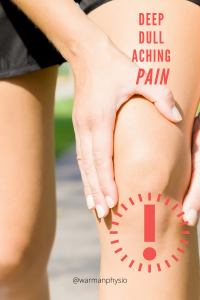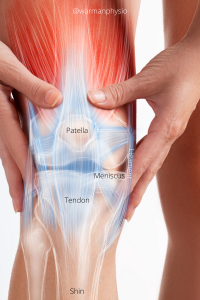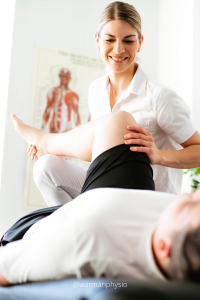At Warman Physio we love a good case study! Our case studies are all hypothetical scenarios and are not based on any one client interaction, but is rather a sum of expectations and experiences. This particular case study we will go through (front of the) knee pain!
Case Study KP
What does it feel like?
An 18 year old female complains of left anterior (front knee) pain. She plays volleyball, basketball, track and field and soccer throughout the year and has noticed for the past year the knee pain in the front has gotten progressively worse. She thinks it may have started after a volleyball tournament but doesn’t recall specifically hurting it. She’s feeling deep, dull aching pain to the front of the left knee that is worse with jumping, squatting, stairs, kneeling, crawling, and running. She has been occasionally putting on ice and taking Advil which helps for a bit, however this is not long lasting. This past summer, she took time away from sport and activities and the knee pain improved. However, when returning to volleyball and soccer this season, symptoms have returned. She is feeling frustrated, and is wondering if the knee pain will ever go away or if this is just “normal” now.

This all-too-familiar story doesn’t just happen at the knee, but can also happen with other areas of the body. Let’s focus on the knee and some of the possible reasons WHY this happens, what we can do about it, and how you can start your road to recovery TODAY!
What Causes Anterior Knee Pain?
There are many reasons why an individual may have front knee pain. One of the most common causes that we see as Physical Therapist are strength/length issues to the lower extremity. What this means is, usually weakness throughout the gluteals, quadriceps, hamstrings and foot intrinsics (muscles just in the foot), can cause issues throughout the leg. These deficits can result in front knee pain, where the quads tendon attaches to the shin. Front knee pain does not require an injury to occur since it usually develops overtime. It often occurs due to overuse, or a training routine that does not include adequate stretching or strengthening. An overuse injury develops when repetitive stress to bone, muscle, and tendon structures uses tissues at a greater rate than the body can repair itself.

Many other factors that can lead to front knee pain such as: changing shoes or poor shoe support, improper exercise and running technique, falling directly onto the knee, Osgood-Schlatter disease, patellofemoral pain syndrome, patellar tendinitis/patellar tendinopathy, etc.
If you have front knee pain, a physiotherapy assessment could benefit you!
What does an assessment look like?
Well – that depends! In most cases what you may expect your therapist to complete a postural evaluation to look at your alignment. In addition flexibility of the lower extremity muscles, strength of the hip, thigh, calf and foot muscles, mobility of the kneecap and knee joint will be completed. Stability of the knee and range of motion of the knee, hip, and ankle will be addressed depending on the specific information provided.
 Once an assessment is complete, your physical therapist will have a good understanding as to why there is persistent front knee pain. If there are restrictions of the patella (knee cap) or knee, the therapist may recommend manual care to help restore the mobility of the knee joint. If there is muscle weakness and muscle shortening, the therapist may recommend stretches and strengthening as a home program. Strengthening can occur in both non-weight bearing and weight-bearing environments, with the use of theraband, if appropriate. Exercises are progressed when appropriate into activity and sport specific movements over time. The client will also be educated on proper technique and alignment to complete squats, step ups (such as with stairs), running, and possibly gait (walk) re-patterning.
Once an assessment is complete, your physical therapist will have a good understanding as to why there is persistent front knee pain. If there are restrictions of the patella (knee cap) or knee, the therapist may recommend manual care to help restore the mobility of the knee joint. If there is muscle weakness and muscle shortening, the therapist may recommend stretches and strengthening as a home program. Strengthening can occur in both non-weight bearing and weight-bearing environments, with the use of theraband, if appropriate. Exercises are progressed when appropriate into activity and sport specific movements over time. The client will also be educated on proper technique and alignment to complete squats, step ups (such as with stairs), running, and possibly gait (walk) re-patterning.
Occasionally, front knee may persist during sport, and a patellar brace to support the patellar tendon may be recommended. This is discussed during your appointments with your physical therapist as to whether a brace would be beneficial.
How long until I am better?
The recovery period usually varies from client to client, depending on the severity and frequency of signs and symptoms. Other factors include:
- How long the pain has been present
- activity level
- commitment to the home exercise program
Straightforward cases we tend to see client’s 1x/1-2 weeks for a total of 4 to 6 sessions. These sessions include manual therapy to help restore joint and muscle mobility as well as exercises for their home program.
Don’t delay! Schedule your assessment today to get started your journey to recovery!

